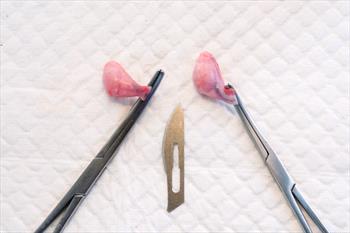Dog testicles post-neuter

These dog testicles were removed during neuter surgery. Photo courtesy of Depositphotos.
Being a veterinarian in an animal shelter can be really hard. And I'm not just talking about the physical labor involved, which can be significant. I'm talking about the emotional labor here. Many folks are aware of the toll euthanasia takes on those who perform it, whether that is animal control officers or veterinary staff. But there's another kind of death that doesn't get much attention: anesthetic and surgical deaths.
Don't get me wrong. High-quality, high-volume spay/neuter (HQHVSN) is quite safe. It is basically performing spay after spay and neuter after neuter while still upholding high standards of surgical and medical care, hence ‘high-quality.' An experienced and efficient team can perform dozens of spays and neuters in a day, hence the 'high-volume' part of the term. One study looking at the mortality rate in these settings found the risk of death within the 24 hours after starting the anesthesia process (the perioperative mortality rate) to be right around 0.03%, which is quite good in veterinary medicine.
But -- HQHVSN usually involves young, healthy animals. The patients I'm talking about are far from young and healthy. Think the adult female pit-bull that has a loud heart murmur and a bad skin condition like severe mange, or the decrepit cat of unknown age with a retained testicle and possible kidney failure. These patients are at increased risk of complications, including death, from anesthesia and surgery.
Some municipalities or states have laws in place requiring all animals to be spayed or neutered prior to leaving the shelter. Sometimes what can happen in low-resource shelters is a push to go ahead with the surgery in elderly and/or unhealthy patients. The thinking is that if the surgery isn't done, the animal can't leave the shelter and will have to be euthanized, so why not just go for it? The issue for the veterinarian in those situations is often that they know what could or should be done. They also know it can't be done at that facility with the resources on hand. But it is possible it could be done elsewhere or with more resources.
Some shelters operate with very basic diagnostic and monitoring equipment and a smaller selection of anesthetic drugs than many general practice veterinary clinics. They also often have fewer medical staff for monitoring animals undergoing anesthesia. For healthy, young patients, this set-up is sufficient to provide excellent surgical care. However, sicker or older patients often need more diagnostic testing, different anesthetic drugs, additional monitoring equipment, and more staff time to make their surgeries safer. Typical private practices can provide that additional advanced care when it is needed; shelters often don't have those same resources.
And therein lies the rub, the moral distress for the veterinarian and the medical team. If more could be done in different circumstances, should the staff hold out for that? Or should they proceed with the anesthesia and surgery knowing there is an increased risk to the animal of complications and/or death, a risk that could be mitigated in the right setting or even with the right preanesthetic test? Should that thought process change when the animal is a stray?
As the veterinarian, I'm not sure others fully understand what it is like to lose a patient under anesthesia. It's not the same as performing a euthanasia. It's heartbreaking in a totally different way. It feels like a personal and professional failure when a patient dies, no matter what the known risks were going in. When we euthanize an animal, we expect death to be the outcome. But with anesthesia and surgery, we expect that animal to wake up again. When that doesn't happen, it is painful, and known risks don't really lessen that pain.
This moral distress is much of the reason many veterinary schools no longer teach surgery to students by doing procedures on live animals and then euthanizing them at the completion of the learning objective. Students have balked over many years until schools have either eliminated practicing surgery on live animals and started using models instead, or they do fewer procedures per animal and recover them for adoption, often by a veterinary student.
So what can you do?
- Ask your shelter what they need! Many shelters publish 'wish lists' on their websites as well as other websites such as Amazon.
- Donate money to your local shelter and request the funds be used for older, unhealthy animals to get diagnostic tests prior to anesthesia, or for additional monitoring equipment.
- Volunteer at your local shelter! You might be able to assist in the surgery area monitoring patients, or your work elsewhere in the shelter will free up employees to assist in surgery.
- Coordinate with your friends or social organization to sponsor the purchase of a big-ticket item. Perhaps the manufacturer would offer a discount for a bit of free publicity!
Not only will donations of material goods or time help the animals, but it will decrease the mental anguish the veterinary staff might have had to face otherwise.
1 Comment
KT
January 15, 2022